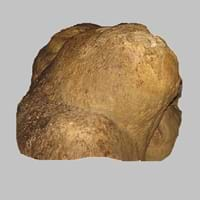Definition
Rhyolite is a fine-grained igneous rock which is rich in silica
Travertine is a mineral consisting of layered calcium carbonate formed by deposition from spring waters
Origin
North America
Italy
Discoverer
Ferdinand von Richthofen
Marcus Vitruvius Pollio
Etymology
From German Rhyolit, from Greek rhuax lava stream + lithos stone
From Italian travertino a kind of building stone, from Tiburs, adjective from Tibur (Tivoli), in Italy
Class
Igneous Rocks
Sedimentary Rocks
Sub-Class
Durable Rock, Hard Rock
Durable Rock, Medium Hardness Rock
Group
Volcanic
Not Applicable
Other Categories
Coarse Grained Rock, Opaque Rock
Fine Grained Rock, Opaque Rock
Texture
Aphanitic, Glassy, Porphyritic
Banded
Color
Grey, White, Light Black
Beige, Black, Blue, Brown, Grey, Red, White, Yellow
Durability
Durable
Durable
Scratch Resistant
Yes
Yes
Appearance
Banded
Fibrous
Interior Uses
Decorative Aggregates, Homes, Hotels, Interior Decoration, Kitchens
Decorative Aggregates, Entryways, Flooring, Homes, Interior Decoration
Exterior Uses
As Building Stone, As Facing Stone, Paving Stone, Office Buildings
As Building Stone, As Facing Stone, Paving Stone, Garden Decoration, Office Buildings
Other Architectural Uses
Not Yet Used
Curbing
Construction Industry
Arrowheads, As Dimension Stone, Building houses or walls, Construction Aggregate, Cutting Tool, for Road Aggregate, Knives
As Dimension Stone, Building houses or walls, Cement Manufacture, Construction Aggregate, for Road Aggregate, Raw material for the manufacture of mortar
Medical Industry
Not Yet Used
Not Yet Used
Antiquity Uses
Artifacts
Artifacts, Jewellery, Monuments, Sculpture, Small Figurines
Commercial Uses
Gemstone, Laboratory bench tops, Jewelry
Cemetery Markers, Creating Artwork, Gemstone, Jewelry, Paper Industry, Pottery
Types
Pumice Rocks, Obsidian Rocks, Perlite Rocks, Porphyritic Rocks.
Not Available
Features
Acidic in nature, Available in lots of colors
Stalactites and stalagmites are formed from this rock, Surfaces are often shiny, Very fine grained rock
Archaeological Significance
Monuments
Not Yet Used
Used
Famous Monuments
Not Applicable
Colosseum in Rome, Italy, Sacré Coeur in Paris, France, Trevi Fountain in Rome, Italy
Sculpture
Not Yet Used
Used
Famous Sculptures
Not Applicable
Data Not Available
Pictographs
Not Used
Used
Petroglyphs
Not Used
Used
Figurines
Not Yet Used
Used
Formation
Rhyolite is a felsic extrusive rock and due to its high silica content, rhyolite lava is very viscous and is volcanic equivalent of granite.
Travertine is a type of sedimentary rock formed when a river carries or transports pieces of broken rock which then undergo sedimentation. They are then subjected to high temperature and pressure hence forming travertine rock.
Mineral Content
Biotite, Feldspar, Hornblade, Plagioclase, Pyroxene, Quartz
Calcite, Clay, Feldspar, Micas, Quartz
Compound Content
Ca, Fe, Potassium Oxide, Mg, Potassium, Silicon Dioxide, Sodium
Ca, NaCl, CaO, Oxygen
Types of Metamorphism
Burial Metamorphism, Cataclastic Metamorphism, Regional Metamorphism
Not Applicable
Types of Weathering
Biological Weathering, Chemical Weathering, Mechanical Weathering
Biological Weathering, Chemical Weathering, Mechanical Weathering
Types of Erosion
Chemical Erosion, Sea Erosion, Water Erosion, Wind Erosion
Chemical Erosion, Coastal Erosion, Glacier Erosion
Grain Size
Large and Coarse Grained
Fine Grained
Fracture
Sub-conchoidal
Splintery
Porosity
Highly Porous
Highly Porous
Luster
Earthy
Dull to Pearly
Cleavage
Not Available
Non-Existent
Specific Gravity
2.65-2.67
1.68
Transparency
Opaque
Opaque
Density
2.4-2.6 g/cm3
2.71 g/cm3
Specific Heat Capacity
Not Available
Resistance
Heat Resistant, Wear Resistant
Impact Resistant, Pressure Resistant, Wear Resistant
Deposits in Eastern Continents
Asia
China, India
China, Russia
Africa
Angola, Egypt, Madagascar, Namibia, Nigeria, South Africa
Not Yet Found
Europe
Germany, Iceland, Ireland, Italy, Spain
Austria, Italy, Portugal, United Kingdom
Others
Not Yet Found
Not Yet Found
Deposits in Western Continents
North America
Canada, USA
Canada, USA
South America
Argentina, Bolivia, Chile, Colombia, Ecuador, Peru, Venezuela
Argentina, Bolivia, Ecuador
Deposits in Oceania Continent
Australia
New Zealand, Queensland, Western Australia
Not Yet Found
All about Rhyolite and Travertine Properties
Know all about Rhyolite and Travertine properties here. All properties of rocks are important as they define the type of rock and its application. Rhyolite belongs to Igneous Rocks while Travertine belongs to Sedimentary Rocks.Texture of Rhyolite is Aphanitic, Glassy, Porphyritic whereas that of Travertine is Banded. Rhyolite appears Banded and Travertine appears Fibrous. The luster of Rhyolite is earthy while that of Travertine is dull to pearly. Rhyolite is available in grey, white, light black colors whereas Travertine is available in beige, black, blue, brown, grey, red, white, yellow colors. The commercial uses of Rhyolite are gemstone, laboratory bench tops, jewelry and that of Travertine are cemetery markers, creating artwork, gemstone, jewelry, paper industry, pottery.










